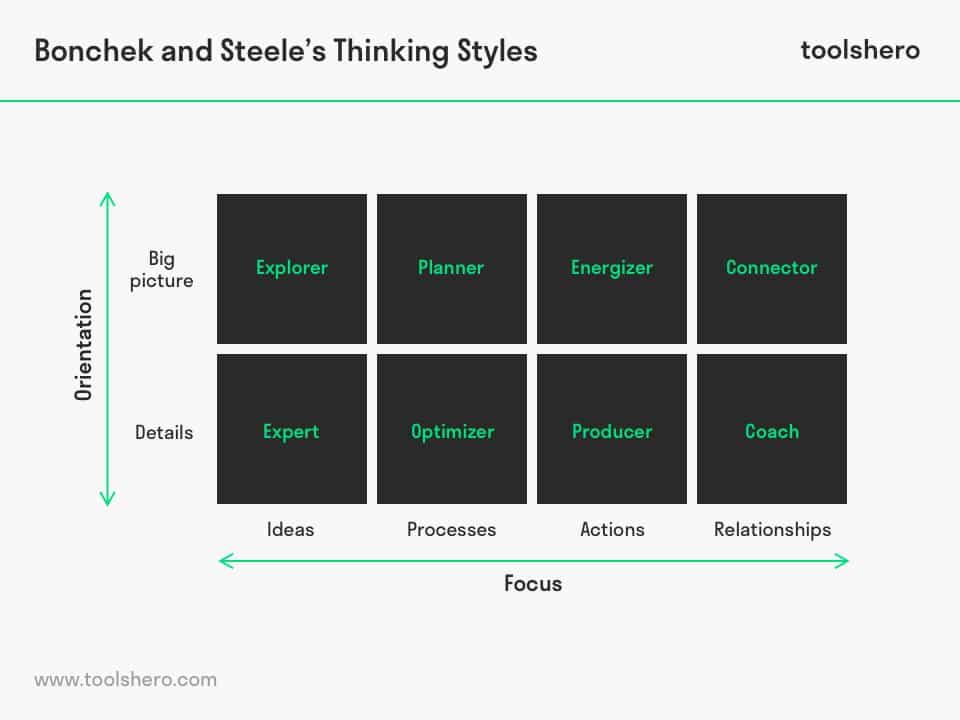Bonchek and Steele Thinking Styles

Thinking Styles: this article describes the Bonchek and Steele Thinking Styles, developed by Mark Bonchek and Elisa Steele in a practical way. After reading you will understand the definition and basics of this powerful management tool.
What are Bonchek and Steele Thinking Styles?
According to the American management consultant Mark Bonchek and American IT expert Elisa Steele, there are eight thinking styles in the workplace.
These ‘thinking styles’ state that individuals are capable of discovering how they can work most efficiently in a team and what their strengths and weaknesses are. Dr. Mark Bonchek is the founder of Shift Thinking and works with executives and CEOs to adjust working methods within organisations and to refocus on the digital age. Elisa Steele was the president of Jive; a provider of modern communication and collaboration solutions for businesses.
Bonchek and Steele Thinking Styles: team composition
When building a team, it’s beneficial to analyse the personalities of the team members. A effective combination of people can be made by finding out whether they’re introverted or extroverted, do or don’t dare to take risks, have an analytical mind or work intuitively.
By knowing beforehand what someone’s preferences are, leaders can better assess an employee’s potential role in a team and their contribution to it. After all, each individual has a certain focus area for ideas, processes, actions or relationships.
With the thinking styles of Bonchek and Steele, teams can speed up their cooperation and increase their involvement. This will ultimately lead to better performances. By knowing how other team members think, each individual can be more energised, creative and involved. This will benefit cooperation and productivity.
Framework
According to Bochek and Steele, two dimensions can be analysed to discover what someone’s individual thinking style is; focus and orientation. By combining these two dimensions, eight thinking styles are created:
Focus
The first step in reaching the eight thinking styles is to identify the focus of someone’s thinking in a specific context. Do they prefer to pay attention to ideas, processes, actions or relationships? Where does the focus lie? Idea oriented people are very creative and like to brainstorm.
Process oriented people prefer to stick to the rules and procedures. Action oriented people keep an eye on what’s happening and how something’s happening. Finally, relationship oriented people find contact between colleagues most important.
Orientation
The second step in identifying the eight thinking styles, according to Bonchek and Steele, is to discover whether someone’s orientation is aimed at the bigger picture (macro) or details (micro). Do they like to focus on specific details, during meetings for instance, or do they mostly see the bigger picture and focus only on the final goal?
8 Thinking Styles
In the third step, these two dimensions are combined, resulting in eight thinking styles. These thinking styles change depending on the environment. In addition, people tend to have a dominant style preference.
The following thinking styles apply on a macro level:
1. Explorer
Big picture / idea oriented; these people are capable of generating creative ideas.
2. Planner
Big picture / process oriented; these people prefer to design effective systems.
3. Energiser
Big picture / action oriented; these people like to encourage others, bring them closer together and manage them and get them into action.
4. Connector
Big picture / relationship oriented; these people are very capable of building and enhancing relationships with others.
The following four thinking styles apply on a micro level:
5. Expert
Detail / idea oriented; these people are capable of being objective and gaining insight.
6. Optimiser
Detail / process oriented; these people are good in improving and optimising productivity and efficiency.
7. Producer
Detail / action oriented; these people focus on completing an assignment and working towards the end goal.
8. Coach
Detail / relationship oriented; these people aim to build good relationships with others and are real ‘networkers’.
Bonchek and Steele Thinking Styles: recognising style
Everyone who knows their personal thinking style can cooperate better with others. Each individual’s thinking style becomes a useful tool for the team. Because people know what motivates or frustrates every team member, it becomes easier to talk about these aspects rather than enter into conflict. One colleague may be more focused on the details of the execution, while another concentrates on the end result.
Bonchek and Steele Thinking Styles example
It’s beneficial for organisations to work with the eight thinking styles. For example, a producer of children’s toys discovered that they employed a large number of ‘explorers’ and very few ‘producers’. This resulted in a continuous flow of great ideas, but a huge lack in terms of the execution of these ideas.
There was a particular lack of decisiveness. The finalisation of details was omitted, as a result of which the work wasn’t carried out efficiently and the company was missing out on profits. By refining the hiring policy and employing more ‘producers’, the organisation was able to turn the tide.
Ideas were developed and implemented more effectively and checking, evaluation and adjustments during the production process became an important working method.
In another example – at an individual level – a leader of a marketing department had been working for years in a department where the introduction of many new ideas was important. After identifying his personal thinking style, he discovered he got more energy and satisfaction from interacting with other people than from creating new marketing campaigns. It turned out he was more of a ‘connector’ than and ‘explorer’. As a result, he decided to focus more on account management and less on marketing. This led to him being more happier and motivated in his work, and made him feel more involved with what he was doing.
It’s Your Turn
What do you think? What is your experience with the Bonchek and Steele Thinking Styles? Do you recognize the practical explanation or do you have more additions? What are your success factors for group dynamics and team development?
Share your experience and knowledge in the comments box below.
More information
- Maccoby, M. (2007). The leaders we need: And what makes us follow. Harvard Business Press.
- Nyre, M. M. (2016). Developing agent-based simulation models of task performance of cognitively diverse teams.
- Wright, J. A. (2017). The Relationship Between Expressed Creative Problem-Solving Preference and Divergent Thinking Attitudes.
How to cite this article:
Mulder, P. (2019). Bonchek and Steele Thinking Styles. Retrieved [insert date] from Toolshero: https://www.toolshero.com/management/bonchek-steele-thinking-styles/
Published on: 02/22/2019 | Last update: 03/25/2022
Add a link to this page on your website:
<a href=”https://www.toolshero.com/management/bonchek-steele-thinking-styles/”>Toolshero: Bonchek and Steele Thinking Styles</a>













